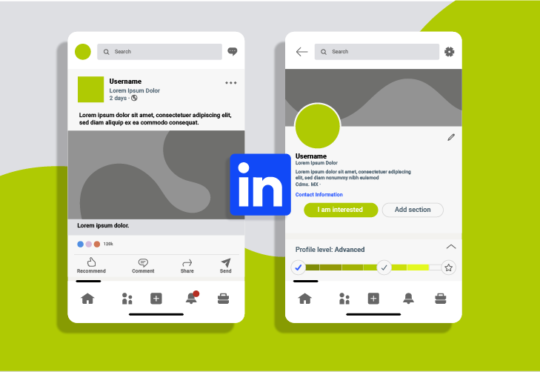LinkedIn has evolved into a dynamic platform, allowing professionals to connect, share, and engage more effectively. One way to improve your visibility and engagement on this platform is by enhancing your posts with visual elements like icons and lists. By incorporating these elements, you can break down complex information, draw attention to key points, and create a more engaging reading experience!
Benefits of Using Icons and Lists in Your Posts

When crafting your LinkedIn posts, integrating icons and lists is not just a stylistic choice but a strategic one. Here’s a closer look at the benefits:
- Improved Readability: Posts with well-structured lists are easier to skim. Readers can quickly identify key takeaways, especially if they’re busy professionals crunching through their feeds.
- Visual Appeal: An eye-catching icon can stand out in a sea of text. It helps capture attention, making your post more likely to be read and shared.
- Enhanced Engagement: People are more inclined to react and comment on posts that are visually engaging. By using lists and icons, you increase the chances of igniting conversations.
- Clear Messaging: Lists help to organize your thoughts coherently. If you're presenting benefits, steps, or features, outlining them in a list format clarifies your message.
- Aid Memory Retention: Icons paired with information can boost memory retention, making your content more impactful. Readers are likely to remember your points if they’re visually reinforced.
Incorporating these strategies not only enriches your content but also establishes your presence as a thoughtful contributor in your professional network.
3. Step-by-Step Guide to Adding a Notebook Icon

If you want to add a notebook icon to your LinkedIn post, it’s a simple yet effective way to grab attention and add a visual flair to your content. Here's a step-by-step guide to help you out:
- Choose Your Icon: Start by selecting an appropriate notebook icon. You can find free icons on websites like Flaticon or IconFinder. Just search for "notebook" and you’ll see a variety of options.
- Download the Icon: Once you’ve found your perfect notebook icon, download it to your device. Make sure to select a size that fits well with your post but isn’t too overpowering.
- Insert the Icon in Your Post: Go to LinkedIn, create a new post, and click the camera icon to upload the notebook icon. You can also drag and drop the downloaded file into the post editor.
- Enhance Your Message: Use the notebook icon as a visual cue to highlight the main point of your post or to introduce a valuable lesson. For example, “Here are my top 5 tips for career development 📝”
- Publish and Engage: Once you’re satisfied with the layout and content of your post, hit publish! Don’t forget to engage with your audience in the comments!
Adding a notebook icon isn't just about aesthetics; it helps break up text and makes your post more shareable and interesting!
4. Creating a List for Your LinkedIn Post

Lists are an excellent way to present information clearly and concisely, especially on a platform like LinkedIn. They help your audience digest your key points without feeling overwhelmed. Here’s how to create an effective list for your LinkedIn post:
- Decide on Your Topic: First, choose a specific topic related to your industry or professional experience. It could range from “Top Skills for 2023” to “5 Books Every Professional Should Read.”
- Limit the Number of Points: Aim for 5-7 items for better readability. This keeps your list concise and easier for followers to remember. Too many points can dilute your message.
- Use Bullet Points or Numbers: List your points using bullet points or a numbered format. For example:
- Time Management
- Networking Skills
- Continuous Learning
| Skill | Description |
|---|---|
| Time Management | Being able to prioritize tasks effectively can significantly boost your productivity. |
| Networking Skills | Building and nurturing professional relationships is key for career growth. |
A well-structured list not only conveys information effectively but also leads to greater interaction with your LinkedIn connections!
5. Best Practices for Engaging LinkedIn Content

Creating engaging content on LinkedIn doesn’t just happen by chance; it requires understanding your audience, crafting your message, and using the right tools. Here are some best practices to elevate your LinkedIn posts:
- Know Your Audience: Start by understanding who your target readers are. Consider their interests and the types of content they engage with the most. This ensures your posts resonate with them.
- Use Visual Elements: Incorporating icons or lists can break down complex information, making it easier for readers to digest.
- Consider using a notebook icon for tips or summaries.
- Utilize bullet points for lists to enhance readability.
- Keep It Concise: Attention spans on social media can be short. Aim for clarity and brevity while still conveying your message passionately.
- Engage with Your Readers: Encourage comments, likes, and shares by asking open-ended questions. Engaging with your audience helps foster community and keeps your posts relevant.
- Post at Optimal Times: Research shows that posting during peak hours can significantly increase visibility. Analyze when your audience is most active and tailor your posting schedule accordingly.
- Be Authentic: Sharing personal stories or insights can make your content more relatable. Authenticity helps build trust and strengthens your personal brand on LinkedIn.
By embracing these best practices, you can craft LinkedIn posts that not only attract attention but also foster meaningful interactions.
6. Examples of Effective Posts with Icons and Lists
Now that we’ve covered best practices for LinkedIn content, let’s dive into some examples that showcase the effective use of icons and lists. These examples can serve as inspiration for your own posts:
- Tip-Driven Post:
Imagine a post with a notebook icon at the beginning, followed by a list of five networking tips, such as:
- Attend industry events.
- Engage with connections’ posts.
- Request informational interviews.
- Follow-up after meetings.
- Offer value before asking for help.
- Project Highlights:
Consider sharing a recent project with bullet points highlighting the key achievements, using a checklist icon. For example:
- Increased sales by 30% in Q1.
- Developed a new marketing strategy.
- Implemented customer feedback loops.
- Industry Trends List:
A post featuring a trendy icon, followed by a list of the top industry trends to watch for the upcoming year. For instance:
- Increased focus on sustainability.
- Remote work becoming standard.
- AI integration for efficiency.
These examples show how you can effectively combine icons and lists in your posts to create engaging, visually appealing content that grabs attention and invites interaction.
Incorporating a Notebook Icon or List in Your LinkedIn Post
In today’s digital landscape, standing out on LinkedIn is key to establishing your professional brand. One effective way to enhance your posts is by incorporating visual elements like a notebook icon or a list. These elements not only capture attention but also organize information in a digestible format.
Here are some reasons to consider adding a notebook icon or a list in your LinkedIn content:
- Visual Appeal: A notebook icon adds a creative touch, making your post more visually engaging.
- Clarity: Lists break down complex information into manageable parts, helping your audience quickly understand your message.
- Improved Readability: Posts structured with lists are easier to scan, increasing the likelihood of readers absorbing your content.
- Encouragement of Engagement: Inviting readers to share their thoughts or create their own lists fosters interaction and engagement.
To effectively incorporate these elements, consider the following tips:
| Tip | Description |
|---|---|
| Choose a Relevant Icon | Ensure that the notebook icon aligns with your post’s content to maintain thematic consistency. |
| Keep It Concise | Limit your list to 5-7 items for optimal readability and engagement. |
| Include a Call to Action | Encourage readers to comment or share their personal lists to boost interaction. |
Incorporating a notebook icon or a structured list in your LinkedIn posts can significantly enhance user engagement and clarity, making your content not just more appealing but also more impactful.
Conclusion: Elevate Your LinkedIn Engagement by leveraging the power of visuals and structured content to connect with your audience effectively.










